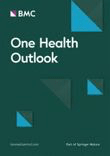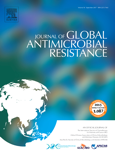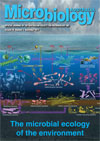
One Health
Scope & Guideline
Bridging Disciplines for a Healthier Tomorrow
Introduction
Aims and Scopes
- Interdisciplinary Research on Zoonotic Diseases:
Focus on the transmission and impact of zoonotic diseases, emphasizing research that spans human, animal, and environmental health. - Antimicrobial Resistance Studies:
Investigating the dynamics of antimicrobial resistance across species and environments, with a particular emphasis on the implications for public health and policy. - Environmental Health and Ecosystem Interactions:
Examining the relationships between ecosystem health, biodiversity, and the emergence of infectious diseases, highlighting the importance of environmental factors. - One Health Policy and Implementation:
Exploring the development and effectiveness of policies aimed at integrating One Health approaches into health systems and practices globally. - Surveillance and Risk Assessment:
Conducting comprehensive surveillance studies to identify and mitigate risks associated with zoonotic diseases and antimicrobial resistance.
Trending and Emerging
- Impact of Climate Change on Health:
There is a growing emphasis on how climate change influences the emergence and spread of infectious diseases, highlighting the need for integrated approaches to tackle these challenges. - Antimicrobial Resistance in the Environment:
Recent publications increasingly focus on the environmental aspects of antimicrobial resistance, exploring how resistance genes disseminate through ecosystems and affect both human and animal health. - Community-Based One Health Initiatives:
Emerging research is emphasizing community engagement in One Health initiatives, recognizing the importance of local knowledge and practices in managing health risks. - Intersectoral Collaboration for Health Security:
A trend towards examining collaborative frameworks that integrate human, animal, and environmental health sectors to enhance health security and response to outbreaks. - Artificial Intelligence and Data Analytics in One Health:
The application of AI and data analytics to predict and manage health risks is on the rise, showcasing innovative methodologies that enhance surveillance and intervention strategies.
Declining or Waning
- Traditional Veterinary Practices:
There is a noticeable decline in papers focusing solely on traditional veterinary practices without integrating broader One Health perspectives, as the field evolves towards more interdisciplinary approaches. - Non-Zoonotic Infectious Diseases:
Research specifically dedicated to non-zoonotic infectious diseases has become less prominent, as the emphasis has shifted towards zoonoses and their interconnections with human and environmental health. - Single-Domain Approaches:
Studies that focus exclusively on human health or animal health in isolation are becoming less common, as researchers increasingly recognize the importance of a One Health framework.
Similar Journals

JAVMA-JOURNAL OF THE AMERICAN VETERINARY MEDICAL ASSOCIATION
Championing the future of animal health and welfare.JAVMA - Journal of the American Veterinary Medical Association, a leading publication in the field of veterinary medicine, has been a cornerstone of veterinary research and practice since its inception in 1945. Published by the American Veterinary Medical Association, this esteemed journal provides a vital platform for disseminating innovative studies, clinical findings, and advancements that enhance the welfare of animals and the practice of veterinary medicine. With an impressive impact factor reflecting its scholarly influence and a position in the top quartile (Q2) among veterinary journals, JAVMA is recognized for its rigorous peer-review process and high-quality content. Although the journal does not offer Open Access, it remains accessible through a variety of academic libraries and institutions, making it a crucial resource for researchers, veterinarians, and students dedicated to advancing the field. With a Scopus rank of #92 out of 194 in the general veterinary category, JAVMA is committed to fostering knowledge and discussions that shape the future of veterinary science.

Infectious Diseases of Poverty
Empowering researchers to tackle health disparities worldwide.Infectious Diseases of Poverty, published by BMC, is a leading open-access journal dedicated to addressing the critical intersection of infectious diseases and poverty. Since its inception in 2012, this influential journal has contributed significantly to the fields of public health, infectious diseases, and environmental health. With impressive rankings placing it in the top quartile (Q1) across multiple categories—including Infectious Diseases and Public Health, Environmental and Occupational Health—it stands as a vital resource for researchers and practitioners alike. The journal's commitment to accessibility ensures that high-quality research is available to a global audience, fostering collaboration and knowledge sharing. Based in the UK, Infectious Diseases of Poverty aims to publish innovative research that sheds light on the complexities of infectious diseases and their socio-economic determinants, ultimately working to improve health outcomes in vulnerable populations around the world. With its robust impact factor and esteemed standing within the academic community, this journal serves as an essential platform for advancing the understanding and management of infectious diseases related to poverty.

One Health Outlook
Uniting disciplines for a healthier world.One Health Outlook is a dynamic open-access journal published by BMC, dedicated to advancing research and discourse within the interdisciplinary field of One Health. With a critical focus on the interconnectedness of human, animal, and environmental health, this journal provides a platform for scholarly discussions that address global health challenges. Launched in 2019 as an open-access resource, One Health Outlook aims to foster collaboration among researchers, practitioners, and policymakers, enabling them to share innovative solutions and data that influence health outcomes worldwide. Its commitment to making research freely accessible enhances its potential impact and reach, making it an invaluable resource for anyone engaged in One Health studies. The journal strives to bridge gaps in knowledge and promote best practices through high-quality research articles, review papers, and case studies, ensuring relevance in an ever-evolving health landscape.

EcoHealth
Bridging Ecology and Health for a Sustainable FutureEcoHealth, published by Springer, is a premier academic journal at the intersection of ecology and health, dedicated to advancing our understanding of the interconnections between environmental conditions and human health. Established in 2004, the journal aims to contribute to the rapidly evolving field by publishing innovative research that addresses the complexities of socio-ecological systems. With an impressive impact factor reflecting its standing in the Q2 category for both Ecology and Health, Toxicology, and Mutagenesis, EcoHealth is highly regarded among researchers and practitioners alike. The journal’s inclusion in top-tier Scopus rankings—125th out of 461 in Environmental Science _ Ecology and 77th out of 148 in Environmental Science _ Health, Toxicology and Mutagenesis—further underscores its significance in the scientific community. EcoHealth is committed to facilitating open discussions and interdisciplinary collaboration, making it an essential resource for students, researchers, and professionals seeking to explore the critical linkages between ecological integrity and public health.

Journal of Infection and Public Health
Transforming Insights into Action for Global HealthJournal of Infection and Public Health is a premier open-access journal published by ELSEVIER SCIENCE LONDON, dedicated to advancing knowledge in the fields of infectious diseases, public health, and environmental health. Since its inception in 2008, this esteemed journal has become a cornerstone of research dissemination, especially after transitioning to an open-access model in 2017, allowing wider accessibility to groundbreaking studies. With an impressive impact factor and ranking in the Q1 category for Infectious Diseases and Public Health as of 2023, the journal stands at the forefront of scientific inquiry, boasting a Scopus rank of #22 out of 665 in Public Health, underscoring its influence and reach in the academic community. Researchers, professionals, and students alike will find the journal's rich repository of peer-reviewed articles invaluable for ongoing education and practice in a rapidly evolving field. For contributing to the global understanding of health dynamics, Journal of Infection and Public Health is a vital resource, inviting scholars to explore, engage, and contribute to the crucial discussions shaping our world.

Lancet Regional Health-Europe
Transforming Health Systems Through Innovative ResearchThe Lancet Regional Health-Europe is a prestigious academic journal published by Elsevier, dedicated to advancing research in the fields of Health Policy, Internal Medicine, and Oncology. As part of a reputable series that focuses on regional health issues, it aims to publish high-quality, peer-reviewed articles that contribute to the understanding and improvement of health systems across Europe. With an impressive impact factor reflected in its Q1 quartile rankings for 2023—ranking #2 in Health Policy, #8 in Internal Medicine, and #22 in Oncology—it is recognized for its significant contribution to cutting-edge research. The journal offers open access options, ensuring that findings are widely disseminated and accessible to researchers, healthcare professionals, and policy-makers alike. By fostering collaboration and interdisciplinary discourse, The Lancet Regional Health-Europe serves as an essential platform for innovative solutions and strategies in health care that address the unique challenges faced within the European context, making it an invaluable resource for academics and practitioners dedicated to public health advancement.

Journal of Global Antimicrobial Resistance
Advancing global solutions to antimicrobial resistance.The Journal of Global Antimicrobial Resistance, published by Elsevier Scientific Ltd, is a premier open access journal dedicated to addressing the critical issue of antimicrobial resistance on a global scale. Established in 2013 and significantly gaining traction as an open access platform since 2020, this journal serves as an essential resource for researchers, healthcare professionals, and policy makers invested in immunology, microbiology, and associated fields. With an impressive impact factor reflected through its consistent ranking in the Q2 category across multiple disciplines, including Microbiology and Immunology – where it ranks #29 out of 140 in Medical Microbiology – the journal ensures high-quality peer-reviewed articles that push the boundaries of current knowledge and practice. By offering a global perspective on research trends and public health implications, the Journal of Global Antimicrobial Resistance plays a pivotal role in advancing the scientific discourse necessary to combat the rising tide of antimicrobial resistance worldwide.

EPIDEMIOLOGY AND INFECTION
Advancing the Science of Disease DynamicsEPIDEMIOLOGY AND INFECTION is a premier open-access journal published by Cambridge University Press, dedicated to advancing the field of epidemiology and infectious diseases. With an ISSN of 0950-2688 and E-ISSN of 1469-4409, this journal has been at the forefront of disseminating impactful research since its inception in 1970. As of 2023, it holds a prestigious Q2 ranking in both the fields of Epidemiology and Infectious Diseases, reflecting its significant contribution to these critical areas of study, with Scopus rankings placing it at #70 in Epidemiology and #163 in Infectious Diseases. The journal aims to publish high-quality, peer-reviewed studies that contribute to our understanding and management of infectious diseases globally. Operating under an open-access model since 2020, EPIDEMIOLOGY AND INFECTION ensures that research is accessible to a wide audience, fostering collaboration and innovation among researchers, professionals, and students alike. With a commitment to excellence, this journal is an essential resource for those looking to stay abreast of the latest developments in epidemiological research and infectious disease management.

Microbiology Australia
Innovating Insights into Australia’s Microbial LandscapeMicrobiology Australia is a prominent journal published by CSIRO PUBLISHING, focusing on the diverse and rapidly evolving field of microbiology. Since its transition to Open Access in 2021, it has broadened its accessibility, fostering greater dissemination of research findings among scholars and practitioners. The journal features a range of topics that are pivotal for understanding microbial systems in applied microbiology, medical microbiology, public health, and environmental applications. Despite its current categorization in the Q4 quartile across several categories, it remains an essential platform for emerging research and innovative methodologies. Researchers and professionals can benefit from the journal's commitment to enriching the global discourse on microbiological advancements. With its ISSN 1324-4272 and E-ISSN 2201-9189, Microbiology Australia caters to a wide audience in Australia and beyond, making significant strides in bridging the gap between research and practical applications in microbiology.

New Microbes and New Infections
Connecting global researchers to combat new infections.New Microbes and New Infections is an esteemed peer-reviewed journal published by Elsevier Sci Ltd that has been a prominent platform for disseminating groundbreaking research in the fields of Infectious Diseases and Microbiology since its establishment in 2013. With an impressive Open Access model, this journal ensures that vital research findings are readily accessible to researchers, healthcare professionals, and academics worldwide. Positioned in the Q2 category for Infectious Diseases and Q3 for Microbiology in 2023, it reaches a significant global audience, as demonstrated by its high Scopus rankings—#44 out of 344 in Medicine: Infectious Diseases, and #34 out of 182 in Immunology and Microbiology. The journal aims to inspire new ideas and foster collaborations by publishing high-quality research focused on novel microbes and infections, thus playing a crucial role in advancing science and public health in an era where understanding infectious agents is more vital than ever.